You love castles, right? Who doesn’t? They’re majestic, mysterious, and full of history.
Well, you’re in luck, because Bavaria has some of the best castles in the world. And they’re not far from Munich, the capital of this beautiful region.
Bavaria’s castles are more than just buildings. They’re stories. Stories of kings and queens, wars and peace, dreams and reality.
They tell you about the past, but also inspire you about the future. They almost make you feel like you’re part of a fairy tale.
In this article, we’ll show you seven amazing castles near Munich that you can visit on your next trip. Each one has something special to offer, whether it’s architecture, art, or scenery.
You’ll learn about their history, their secrets, and their charm. You’ll also get some tips on how to make the most of your visit.
So, are you ready to explore some of the most spectacular and popular castles near Munich? Let’s go!
As you explore castles near Munich, Neuschwanstein Castle is one you cannot miss. This iconic castle was built by King Ludwig II as a tribute to the legendary composer Richard Wagner.
Imagine yourself standing at the foot of this fairy-tale castle, with its stunning architecture inspired by the romance of the medieval period.
Disney enthusiasts particularly shouldn't miss out on this experience, as Neuschwanstein Castle served as inspiration for Walt Disney's Sleeping Beauty Castle.
They called Ludwig II the Fairytale King or Mad King Ludwig. But when you see the setting - surrounded by the Bavarian Alps and with the tranquil lake below - it's easy to understand why he chose this idyllic location for his royal palace.
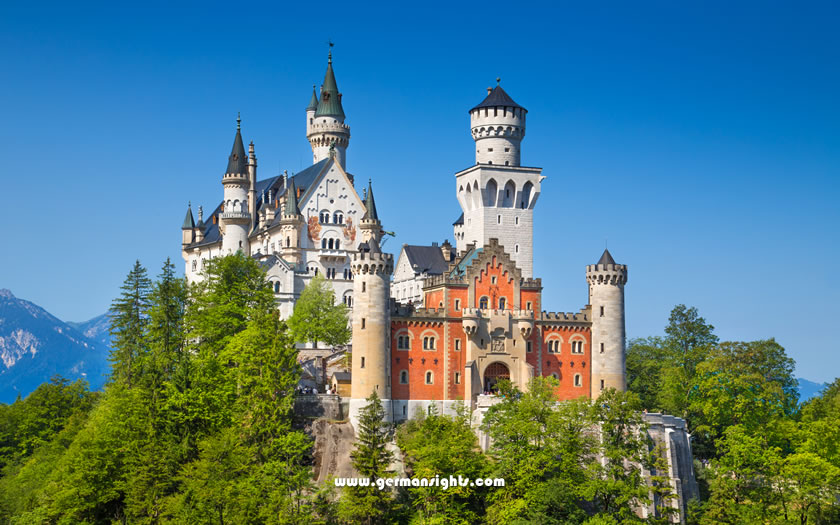 Schloss Neuschwanstein
Schloss Neuschwanstein
During your visit, be sure to explore the highlights of this magnificent castle on the guided tour of the interior.
You will see the dazzling Throne Hall and appreciate the intricate murals, gold leaf decorations, and stunning chandeliers reflecting King Ludwig's opulent taste.
As you wander through the Singer's Hall, you'll undoubtedly be impressed by the decoration reflecting Ludwig's obsession with the knights and legends of German history.
And don't forget to walk over the Marienbrücke, a bridge that offers a stunning vantage point for capturing the perfect photo of Neuschwanstein Castle.
The only way to see the interior of the castle is on a guided tour, giving you the history and stories of Neuschwanstein Castle. Tours must be reserved from the ticket office at the bottom of the hill, where you will be allocated a specific time for entrance.
It is possible to reach Neuschwanstein Castle from Munich on public transport, using the Bayern Ticket that covers unlimited travel on regional train services in Bavaria (and most buses) for a day.
However, the journey will involve several changes from train to bus and it is honestly much easier to take one of the organised day trips to the castle from Munich.
Try a day trip to both of Ludwig's castles - Neuschwanstein Castle and Linderhof Castle by bus
If you want to see where King Ludwig II spent his childhood, you should visit Hohenschwangau Castle.
This 19th-century palace was built by his father, King Maximilian II, on the ruins of a medieval fortress. The castle is located just outside the village of Schwangau, near the Schloss Neuschwanstein and the Alpsee lake.
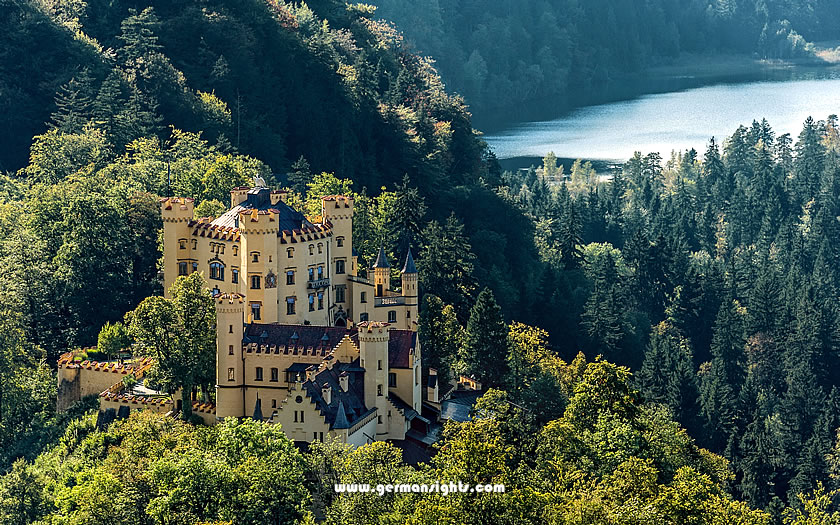
Hohenschwangau Castle
Hohenschwangau Castle is a treasure trove of art and history. You can admire the frescoes and paintings that depict scenes from German legends and history, such as the Nibelungenlied and the Swan Knight.
You can see the rooms where Ludwig II and his brother Otto lived, studied, and played. You will get an insight into their dreams, passions, and tragedies.
You can explore the formal castle gardens created in the 19th century, which features fountains illustrating various themes and influences on the castle.
You can also visit the nearby Museum of the Bavarian Kings, which showcases the history and legacy of the Wittelsbach dynasty.
You can book your tickets online or at the Ticket Centre Hohenschwangau near the castle itself.
Bus and train travel details are the same as for Schloss Neuschwanstein.
Entering the magical realm of Linderhof Palace, you’ll immediately notice the impact of Versailles on King Ludwig II’s vision.
This smaller, but still magnificent palace, also known as Schloss Linderhof, displays the king’s fascination with French style and splendour.
As you wander through the rooms on the official tour, your eyes will be dazzled by the lavish use of gold, mirrors, porcelain, and sculptures decorating the interiors.
The glorious Hall of Mirrors is modelled after its counterpart in the Munich Residence. The elaborate ceiling and ornaments reflect the grandiosity of the era.
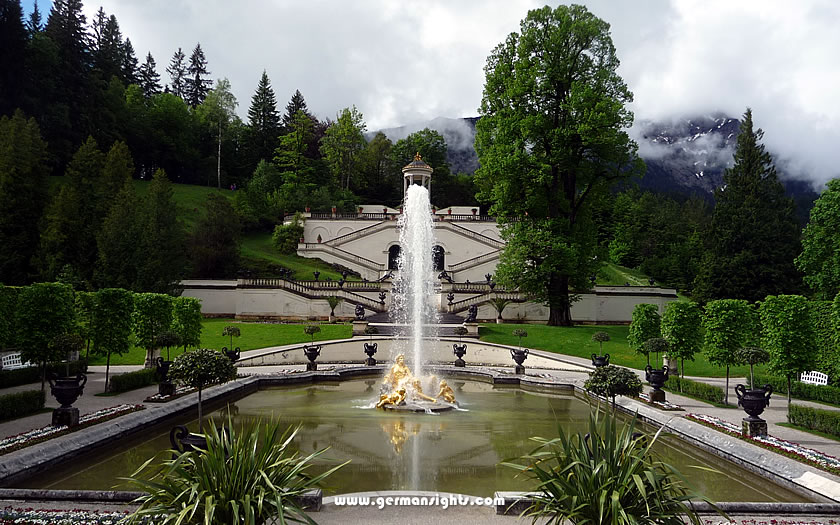
Linderhof Castle fountain
Heading outside, you’ll find yourself discovering a spacious park surrounding the palace. Enjoy the spectacle of the fountains, statues, and pavilions scattered across the landscape.
One highlight that usually should not be skipped is the Venus Grotto, an artificial cave that was used as a private sanctuary for the king. Unfortunately, this is undergoing restoration until 2024. Other attractions in the grounds are still available, however.
Once again, entrance to the palace and to other attractions in the grounds is only available as part of an official guided tour.
Public transport to Linderhof is a little easier than to Neuschwanstein and Hohenschwangau. The Werdenfels ticket, a cheaper but similar rail deal to the Bayern Ticket, covers train travel to Oberammergau from Munich central station and the bus onwards to Schloss Linderhof.
Try a day trip to both of Ludwig's castles - Neuschwanstein Castle and Linderhof Castle by bus
You'll find the magnificent Schleißheim Palace just a few miles north of Munich, in the town of Oberschleißheim.
The complex is made up of three main palaces: the Old Schleißheim Palace, the New Schleißheim Palace, and Lustheim Palace.
Max Emanuel, a ruler of Bavaria towards the end of the 17th century and the beginning of the 18th century, made major contributions to the development of Schleißheim Palace as he expanded it during his reign.
Initially, the complex served as the summer residence for the Bavarian electors (rulers of the Electorate of Bavaria) before eventually accommodating Bavarian kings too once the state became a kingdom.
The Old Palace was developed from the former manor and farm in the 17th century. It is considered an example of Italian-style villa architecture. Much of it was destroyed in World War II but it has now been rebuilt.s
Lustheim Palace was another smaller Italianate development, with its ceiling frescoes.
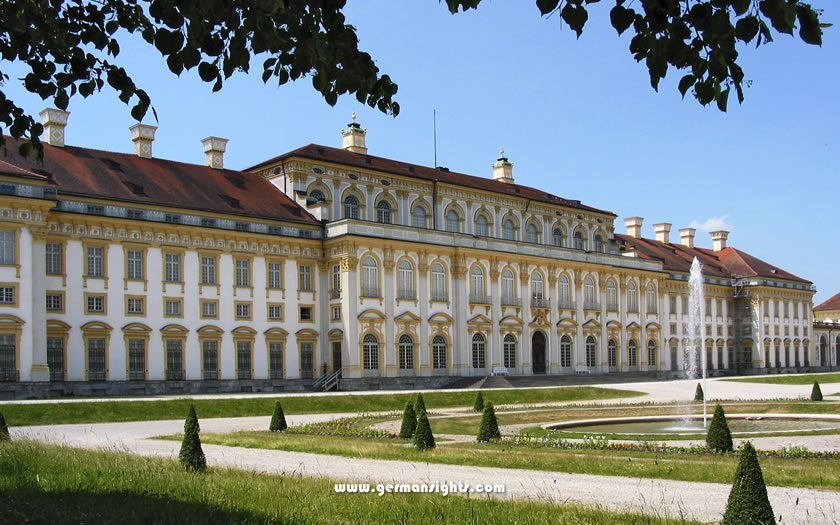
The New Palace in the Schleißheim Palace complex
The largest of them, the New Palace, was built at the beginning of the 18th century. With its ceiling frescoes and interiors, it is considered one of the most magnificent Baroque palaces still in existence.
A collection of paintings from the State Gallery of European Baroque Art in the New Palace includes renowned artists such as Rubens and Van Dyck. The Old Palace houses a collection of Meissen porcelain.
Individual entrance tickets are available for each of the palaces, as well as a combination ticket covering all three. The palaces are closed on Mondays.
While exploring Schleißheim Palace, you'll come across vast green lawns and lovely water features decorating the palace's extensive gardens. Take a stroll around the gardens to allow yourself to soak in the palace's charm and grandeur.
Schleißheim Palace is one of the more accessible palaces from the city, so make sure to add it to your Munich sightseeing itinerary.
Public transport access is via the S1 suburban rail service out towards Munich airport. Exit at the stop for Oberschleißheim and walk around a quarter of an hour to the palace complex.
There are no official guided tours for the buildings, although an audio guide in various languages is available for the New Palace.
Note that a section of the Deutsches Museum is located at Oberschleißheim next to the Schleißheim Palace complex. The Flugwerft Schleißheim is an aviation museum with 70 planes and gliders from the beginning of flight through to the present day.
You'll actually find Nymphenburg Palace, also known as Schloss Nymphenburg, within the Munich city limits.
This former summer residence of Bavaria's royal family served as a tranquil retreat for King Maximilian II and his successors away from the dirt and grime of the city centre.
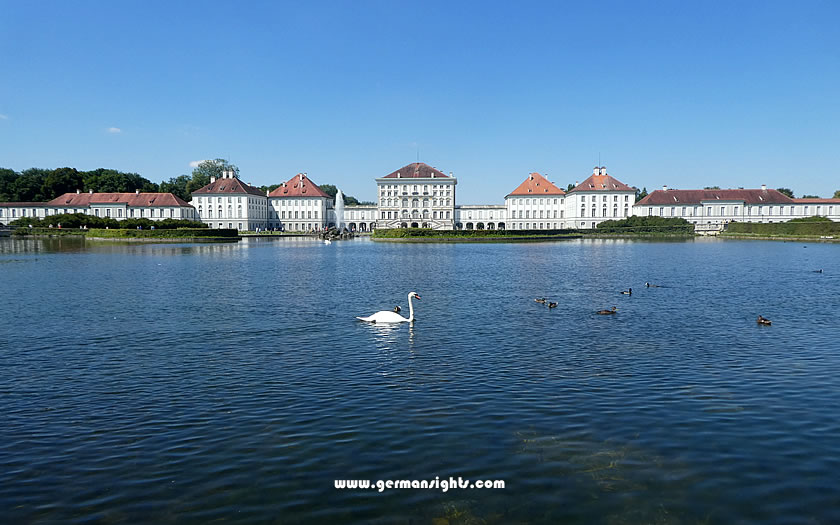 Schloss Nymphenburg in Munich
Schloss Nymphenburg in Munich
The palace is an enchanting representation of Baroque architecture, adorned with exquisite details and surrounded by lush gardens.
As you approach the palace, you'll be captivated by its grand facade stretching over 700 meters long. Upon entering, the stunning Great Hall welcomes you with its elegant array of columns, frescoes, and ceiling murals.
Nymphenburg Palace is not only a testament to majestic architecture but also a treasure trove of art and culture. As you wander through the palace, you'll come across a variety of museums and collections that showcase the rich history and artistic mastery of Bavaria:
Aside from the architectural splendour and cultural heritage, Nymphenburg Palace offers an equally enchanting outdoor experience. The expansive palace park, spanning over 200 hectares, invites you to take a leisurely stroll, admire the manicured lawns, glistening lakes, and romantic water features. While meandering through the grounds, you might even spot a grazing deer, adding a touch of nature's grace to this picturesque landscape.
Venturing further, you'll discover four smaller palace buildings hidden away in the grounds, each boasting its unique charm and historical significance.
In summary, Nymphenburg Palace offers you an unforgettable journey through Bavaria's royal history, architectural mastery, and natural beauty. A visit to this enchanting palace should be on the top of your list when exploring Munich and its surrounds.
Imagine stepping into a world of regal splendour and breathtaking beauty – welcome to Herrenchiemsee Palace. Schloss Herrenchiemsee, as it is known in German, is situated on the Herreninsel island in the Chiemsee lake.
This grand palace in a stunning location was built as King Ludwig II's homage to the Palace of Versailles.
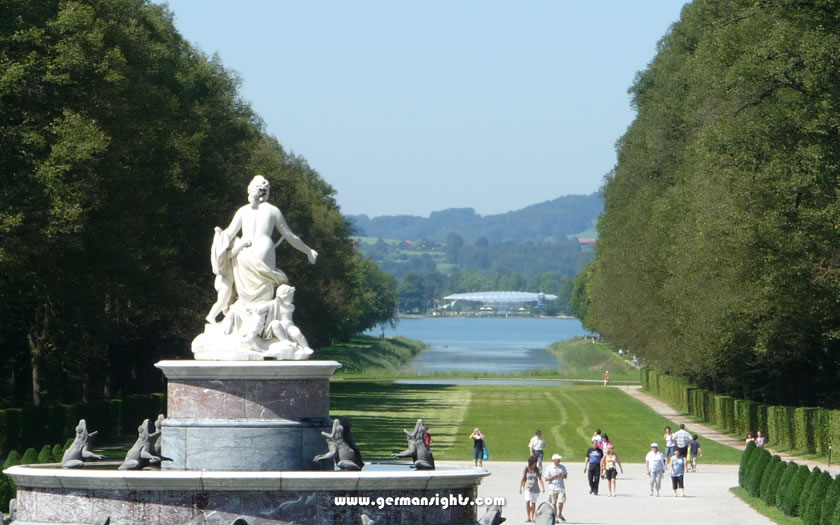
Herrenchiemsee Palace
From the hall of mirrors to the state bedroom and the exquisite collection of porcelain, the palace's extravagance is nothing short of mesmerising.
But like any colossal project, Herrenchiemsee Palace faced its fair share of challenges. With the high costs, time constraints, and lack of space on the island, it's no wonder some parts of the palace remain unfinished.
Nevertheless, the palace stands as a testament to the lofty ambitions of King Ludwig II and a stunning example of Baroque architecture.
Those interested in Ludwig II, his life and his dreams might wish to visit the Museum on the ground floor of the palace. Twelve rooms display the building plans for his various projects and his personal furniture from some of the other palaces.
Tickets are available for both the palace and museum individually or as a combination ticket. Only official guided groups are allowed to enter the palace rooms.
The easiest way to visit Herrenchiemsee without driving is by taking the train from Munich central station to Prien am Chiemsee. The town is connected to the lake by a short private train but it is only a 30-minute walk from the main railway station to the ferry landing. Regular boats take visitors across to the Herreninsel island. From the landing stage on the island, it is a 20-minute walk to the palace.
Trausnitz Castle was once the seat of the Wittelsbach family, an important lineage in the rulers of Bavaria. The castle is situated in the lofty position above the town of Landshut to the northeast of Munich.
It is a mixture of architectural styles - no wonder, when you consider that its history dates back to the founding of the town in the 13th century.
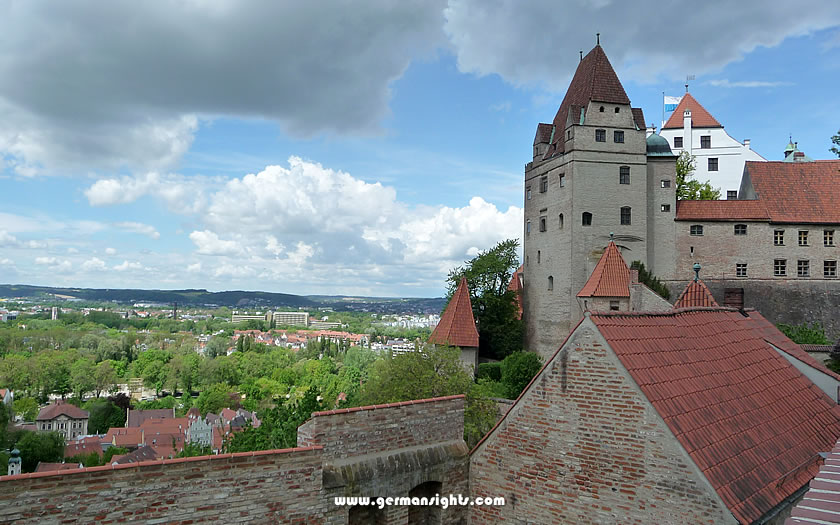
Trausnitz Castle in Landshut
As you wander through the fortifications, you'll notice the mixture of styles - the Gothic tower, the Renaissance courtyard, and the tower terrace. It's evident that the castle evolved through different periods, showcasing the tastes and preferences of the royals who occupied it at any time.
The museum in the castle holds items from a Chamber of Art and Curiosities ('Kunst- und Wunderkammer'). These types of collections were popular among rulers in the Renaissance era and consisted of works of art or unusual items from around the globe.
Admission to the castle is as part of a guided tour (German language only), except on Sundays, when visitors are free to tour the rooms on their own. The museum entrance is included in the ticket with no guided tour.
Landshut can be reached by train from Munich station. The journey takes around 50 minutes. The castle is around three kilometres from the main train station, although those interested in spending a day here may break the distance by looking around the old town centre before visiting the castle.